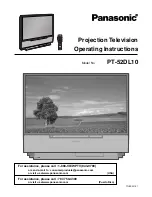
Kawakami says. “The greater number of
channels is useful in directing that envelop-
ing ambient sound.” Kawakami says that
producers are more conservative with the
surround sound on classical than they are
with pop. “Few orchestras or classical producers want to
take liberties – they’re not going to have the instruments
coming from behind you. They’re trying to recreate the feel-
ing of sitting in the hall, in the best possible seat, with a
wide and deep soundstage, with the instruments placed
a c c u r a t e l y. Coming from behind would be reflections of
sound, and sounds from the audience, so it feels like a hall.”
Steven Epstein, who produced the DVD Karajan record-
ings, went back to the original multi-track recordings. “The
1987 New Ye a r ’s Concert had pick-up mikes hanging in the
audience,” he says. “We fed that information to the rear
channels, added a little reverb to glue the perspective from
front to rear, and added a slight delay to get more of a sense
of distance from the front to the rear, which enabled us to
achieve a realistic surround sound. The Beethoven
N i n t h
was recorded without ambient mikes, so we used informa-
tion from the main mikes as well as the spot mikes in the
orchestra. First we remixed the stereo, and brought it into a
more present-day natural sound. Then we took information
from the two main mikes and brought it to the rear ones,
but we had to process it, to recreate the sense of depth. We
used delay, some additional reverb, and equalized the sound
to get a believable result.” (See review of three Karajan
DVDs, this issue.) Producers working on popular concerts
sometimes get fancier. “You can put a guitar solo or a drum
solo front and center, tailoring the audio to feature what’s
on the video at that moment,” Cohen says.
Back to the numbers, however. Classical has its own
peculiarities, particularly within major labels. When sales of
5,000 have been considered typical – indeed, good – for a
single audio title, labels have to think carefully before com-
mitting resources to a project. After the industry downturn
in the 1990s, which saw a major reduction in the number
and kinds of classical audio releases put onto the market, it
is not surprising that these companies are taking a relative-
ly conservative approach to the new format, which adds big
bucks to the production costs. Classical video isn’t exactly
a mass-market seller anyway. Paul Gruber points out that
many of the classical VHS titles are going out of print. “The
audience just isn’t big enough for the big companies now, ”
he says.
The one major label to come out ahead of the pack with
new product is BMG Classics, which several months ago
released its DVD version of Puccini’s
Turandot
, as lavishly
performed last September in the Forbidden City of Beijing.
Why this one? David Kuehn, VP marketing and A&R director
On a recent visit to Manhat-
tan’s major Tower store, there
were just 23 classical DVDs
available.
Upscale Pop
D
VD is having a profound impact on how pop record
companies look at music videos for the home market.
“It’s almost reinvented the business, now that we
have a system that delivers a high-quality picture and high-
quality audio,” says John Beug, senior VP, film/video produc-
tion and marketing for Warner Bros. Records. “Not to cast
aspersions on VHS, but the audio quality stinks and the picture
quality depends on who is duplicating it.”
Music video programs on DVD are now released routine-
ly by pop labels and are available from scores of acts, from the
Allman Brothers to Yes. But record companies still are selec-
tive in choosing acts for DVD treatment, given additional pro-
duction costs of $10,000 to $30,000 per title. “It certainly
appears as though the slightly older, slightly upper-demo-
graphic artists are selling better,” says Beug.
A recent ranking by Amazon.com of its best-selling music
video releases on DVD included titles from Eric Clapton, B.B.
King, Neil Diamond, Earth Wind & Fire, and Sarah McLachlan.
But also in the Top Ten were Michael Jackson and Madonna,
acts with a younger appeal.
“DVD was originally skewing toward older fans and clas-
sic releases,” agrees Leslie Cohen, VP of business develop-
ment for Sony Music. “But now with DVDs from groups like
Oasis and Savage Garden and Pearl Jam, we’re obviously
reaching out to younger listeners, and also trying to capitalize
on the existence of a fairly large CD-ROM population, which is
completely underserved.” The thinking here, says Cohen, is
customers won’t watch DVD films on small computer screens
but they will play music programs on their PCs.
Pop music fans, like their classical counterparts, are drawn
to the consistently high sound quality of DVD titles, whether
provided through Dolby AC-3 [Dolby Digital], Dolby 5.1, PCM
Digital Stereo, or the Digital Theater Systems (DTS) alterna-
tive, which requires a decoder-equipped DVD player.
While the quality of DVD audio and video is relatively con-
sistent, interactive content is not. Pop record companies differ
in their approach to DVD programming. Pop music DVDs may
include biographies, discographies, song lyrics, interviews,
and more.
James Taylor Live at the Beacon
, a made-for-DVD
release with several interactive elements, has outsold its VHS
counterpart 2-to-1, says Cohen at Sony Music, which is explor-
ing web-links and gaming elements in future music DVD titles.
Metallica’s
Cunning Stunts
concert DVD offers multiple cam-
era angles, interviews, and a photo gallery of nearly 2,000
shots. (See review, TPV 25.)
“I appreciate all those bells and whistles but I tend to be
pretty traditional and I’m really focused on the audio and pic-
ture quality,” says John Beug at Warner Bros., which has
released straightfor ward music programs on DVD from Clap-
ton, R.E.M., Prince, Frank Sinatra, Fleetwood Mac, Alanis
Morissette, and others.
As classical and pop fans embrace DVD, record company
executives now wonder if the format will work in other gen-
res. “How much more will the business ‘sectionalize’ itself?”
asks Beug. “We know the classical stuff works. Will this work
for country?”
How about a Garth Brooks concert on DVD with an inter-
active choice of hats?
THOM DUFFY
Thom Duffy is International Deputy Editor of
B i l l b o a r d
magazine.
















































